The Qualcomm Snapdragon 820 Performance Preview: Meet Kryo
by Ryan Smith & Andrei Frumusanu on December 10, 2015 11:00 AM EST- Posted in
- SoCs
- Snapdragon
- Qualcomm
- Snapdragon 820
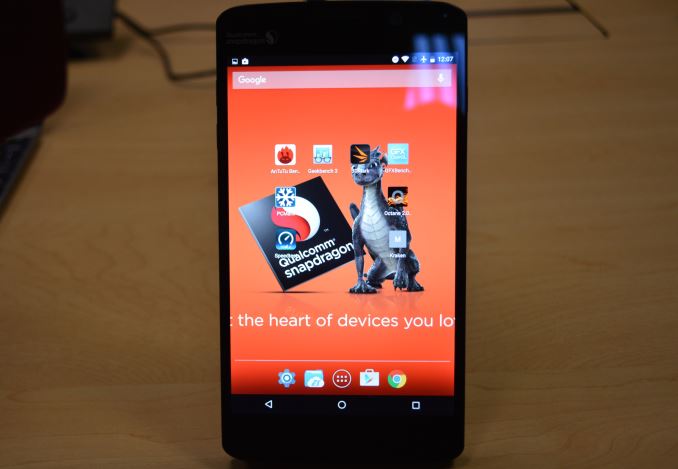
I don’t think there’s any way to sugarcoat this, but 2015 has not been a particularly great year for Qualcomm in the high-end SoC business. The company remains a leading SoC developer, but Snapdragon 810, the company’s first ARMv8 AArch64-capable SoC, did not live up to expectations. Seemingly held back by design matters and a rough 20nm planar manufacturing process – a problem shared by many vendors in the last year – Snapdragon 810 couldn’t make good use of its highly clocked ARM Cortex-A57 cores, and ultimately struggled in the face of SoCs built on better processes such as Samsung’s surprisingly early Exynos 7420.
But the purpose of today’s article isn’t to reminisce about the past, rather it’s to look towards the future. Qualcomm knows all too well what has happened in the past year and the cost to the company that has come from it, so now they need to dust themselves off and try again. With Samsung’s more advanced 14nm FinFET process in hand, a new CPU core, a new GPU, and a number of other advancements, Qualcomm is ready to try again; to try to recapture the good old days of 28nm and their Krait CPU architecture.
To that end Qualcomm started talking about Snapdragon 820 early and doing so loudly. Last month the company held their first press demonstration of the SoC, showcasing early demonstrations in action and going into more detail than ever before on their performance and power projections for their next-generation SoC.
If there is any unfortunate aspect to any of this, it’s that while Qualcomm is showing off Snapdragon 820 today, it won’t be ready for the holidays (lining up with what we expect will be the typical spring smartphone refreshes). But some of this is clearly driven by Qualcomm’s business needs and the aforementioned effort at Qualcomm to quickly pick themselves up and try again.
Meanwhile after last month’s demonstrations, this month Qualcomm is ready to move on to the next phase in what has become their traditional roll-out process for a new SoC: giving the press access to the company’s Mobile Development Platform (MDP) devices. Designed for software developers to begin building apps and (for lack of a better word) experiences around the new SoC, the MDP is something of the home-stretch in SoC development, as it means Qualcomm is ready to let the press and developers see the hardware and near-final software stack. We’ve previously previewed the Snapdragon 800, 805, and 810 via their MDPs, and for Snapdragon 820 Qualcomm has once again opted to do the same. So without further ado, let’s take our first look at Snapdragon 820.
| Qualcomm Snapdragon S810 Specifications | |||
| SoC | Snapdragon 820 | Snapdragon 810 | Snapdragon 800 |
| CPU | 2x Kryo@1.593GHz 512KB(?) L2 cache 2x Kryo@2.150GHz 1MB(?) L2 cache |
4x A53@1.555GHz 512KB L2 cache 4x A57@1.958GHz 2MB L2 cache |
4x Krait 400@2.45GHz 4x512KB L2 cache |
| Memory Controller |
2x 32-bit LPDDR4 @ 1803MHz 28.8GB/s b/w |
2x 32-bit LPDDR4 @ 1555MHz 24.8GB/s b/w |
2x 32-bit LPDDR3 @ 933MHz 14.9GB/s b/w |
| GPU | Adreno 530 @ 624MHz |
Adreno 430 @ 600MHz |
Adreno 330 @ 600MHz |
| Mfc. Process |
Samsung 14nm LPP |
TSMC 20nm SoC |
TSMC 28nm HPm |
Taking a trek down to sunny San Diego, Qualcomm handed to us the Snapdragon 820 MDP/S. A 6.2” phablet, the MDP/S is a development kit designed for function over form, containing a full system implementation (sans cellular) in an otherwise utilitarian design. Along with the Snapdragon 820 SoC, the 820 MDP/S also includes a 6.2” 2560x1600 display, 3GB of LPDDR4 memory runnning at a slightly higher 1804MHz instead of 1555MHz we've seen on the Snapdragon 810 and Exynos 7420, a 64GB Universal Flash Storage package, a 21MP rear camera, 802.11ac WiFi, and a Sense ID ultrasonic fingerprint scanner. Overall the aesthetics of the MDP/S differs significantly from what retail phones will go for, but internally the MDP/S won’t be far removed from the kinds of configurations we’ll see in 2016 smartphones.
Overall there’s little to report on the MDP/S experience itself. Qualcomm is still sorting out some driver bugs – only one device in our group was ready to run PCMark – and to be sure like past Qualcomm MDP previews this is very much a preview. However the experience was otherwise unremarkable (in a good way) with our unit completing all of our tests bar part of SPEC CPU 2000, which will require further analysis.
More interesting from a testing perspective is that Qualcomm opted to demonstrate Snapdragon 820 using the MDP/S smartphone development kit, instead of a larger MDP/T tablet development kit. Qualcomm has used MDP/T for the press demonstrations on both Snapdragon 800 and Snapdragon 810, so the fact that they are once again using the MDP/S is very notable. From a pure performance perspective the MDP/T allowed Qualcomm to show off previous Snapdragon designs at their best – these are just performance previews, after all – but after Snapdragon 810 I don’t doubt that had this been another MDP/T that the 820’s thermals and power consumption would be called into question. So instead we are looking at 820 in a phablet, and while this may not put 820 in the best possible light, the end result is that we get to see what performance in a large phone looks like, and for Qualcomm there isn’t any doubt about 820’s suitability for a smartphone.
As for Snapdragon 820 itself, we’ve already covered the SoC in some depth in past articles – and this week’s preview doesn’t come with much in the way of new architectural information – but here’s a quick recap of what we know so far. 820 uses a new Qualcomm developed CPU core called Kryo. The quad core CPU is best described as an HMP solution with two high-performance cores clocked at 2150 MHz and two low-power cores clocked at 1593MHz. The CPU architectures of both clusters are identical, but with differences in cache configuration and their power/frequency tuning.
Meanwhile the GPU inside 820 is the Adreno 530. This is a next-generation design from Qualcomm and includes functionality that until now has only been found in PC desktops, such as shared virtual memory with the CPU, which allows an OpenCL host program and a device's kernel to share a virtual address space so access to data structures like lists and trees can be easily shared between the host and GPU. The underlying architecture is capable of Renderscript and OpenCL 2.0 on the compute side – a significant step up from Adreno 400 – and on the graphics side supports OpenGL ES 3.1 + AEP and Vulkan. We know the 530 should be powerful, but like past Qualcomm designs the company is saying virtually nothing about the underlying architecture.
Finally, while it’s not something that can be covered in our brief testing, the 820 contains a new DSP block, the Hexagon 680. Hexagon 680 and its Hexagon Vector Extensions (HVX) are designed to handle significant compute workloads for image processing applications such as virtual reality, augmented reality, image processing, video processing, and computer vision. This means that tasks that might otherwise be running on a relatively power hungry CPU or GPU can run a comparatively efficient DSP instead. The HVX has 1024-bit vector data registers, with the ability to address up to four of these slots per instruction, which allows for up to 4096 bits per cycle.


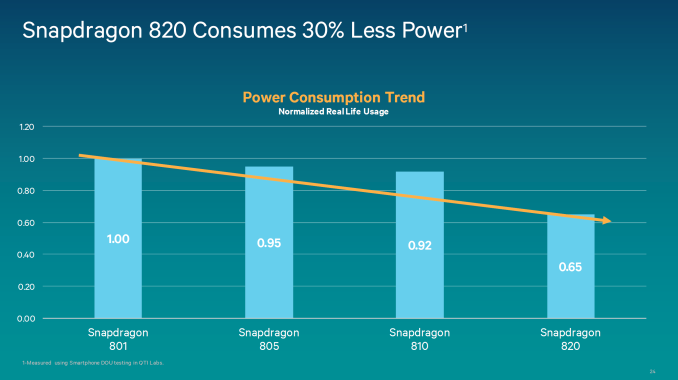
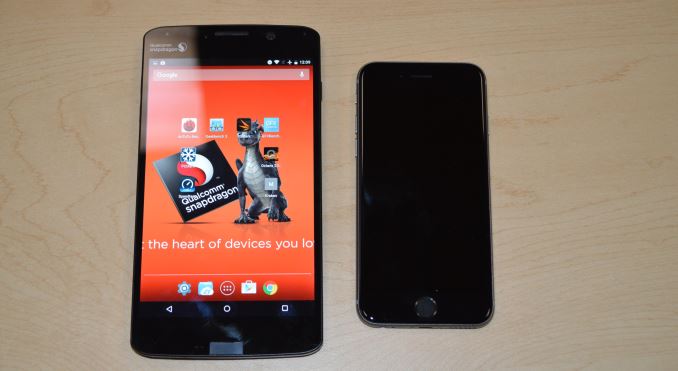
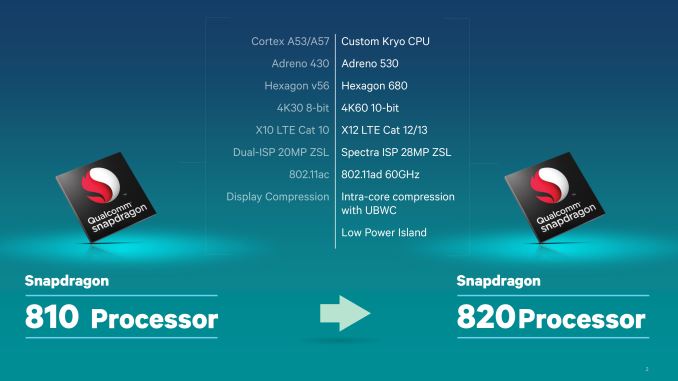
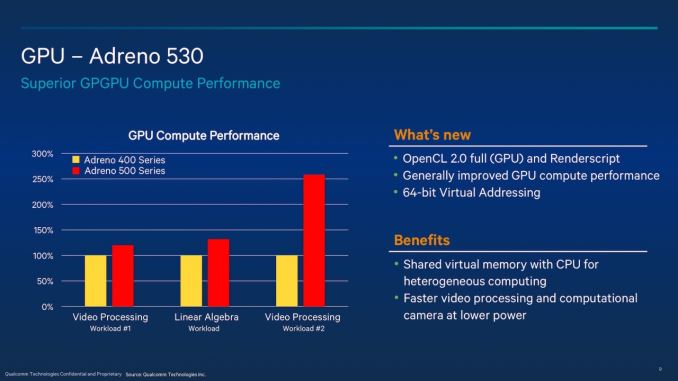
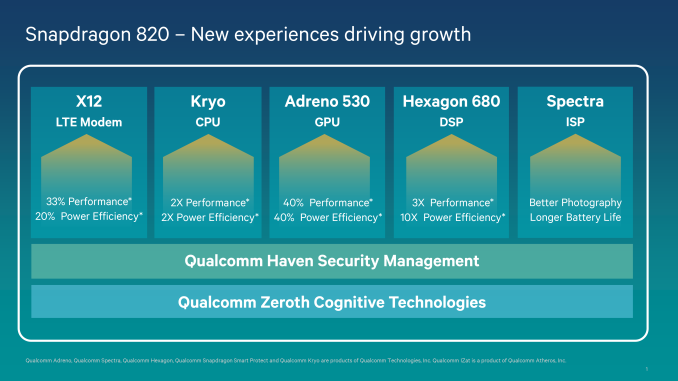








146 Comments
View All Comments
BurntMyBacon - Monday, December 14, 2015 - link
@V900: "Actually Samsung probably wouldn't save any money by using an Exynos SOC."They'd most likely save some. Just not enough to forgo a better chip if available.
@V900: "I doubt Apple would let them manufacture their CPUs if they weren't seperate divisions and had firewalls between them."
The "firewall" would exist around the fabrication facilities only. R&D and architecture design have no bearing on Apple products. If they are sufficiently proficient at design and the cost of the ARM IP doesn't eat the savings, then they could save some here.
@V900: "The two divisions are independent of each other, which means that Samsung the SOC vendor charges Samsung the device vendor the same prices they charge everyone else."
Current fabrication facilities (TSMC, GloFlo, et al) don't charge the same price per customer. They will give discounts for volume, customer loyalty, just to keep the fabs busy, etc.. Samsung could charge themselves preferred pricing, but it certainly wouldn't be free. How much they could save here is dependent on what they charge vs their competitors (I.E. TSMC) and if there is any margin for preferred pricing. Sometimes they will give their competitors very low margin pricing just to keep the fab busy until they have their next push. Samsung has generally been short on supply, so this hasn't happened much, but given their new expansion, it may be a consideration in the future.
zeeBomb - Thursday, December 10, 2015 - link
Damn it, late!WorldWithoutMadness - Thursday, December 10, 2015 - link
I suppose if they're gonna use Qualcomm one last time, it would be for S7 and Note6. Chances are pretty good to accommodate those who are 'stubborn' with Qualcomm's stuff.After that, they are going to use their M1 and its derivative for everything else, better margin in saturated market is their goal in the first place.
Well this wouldn't be long until Google release their own processor design to standardize Android's madness
zeeBomb - Friday, December 11, 2015 - link
So the summary is...the CPU of Kryo is getting some major competition to Apples A9 but the GPU is great, beating the A9 in many of the tests.Also... The Kyro Snapdragon 820 attained a high 131648 and the Kirin 950 with 95280. Thoughts?
http://www.gizmochina.com/2015/12/11/snapdragon-82...
gg555 - Sunday, December 20, 2015 - link
It has already been heavily leaked that the S7 will use the 820 in some markets.yeeeeman - Friday, March 13, 2020 - link
I can tell you from the future that Samsung will use both Exynos and Snapdragon for GS7. The exynos chip with custom mongoose cores is better.Krysto - Thursday, December 10, 2015 - link
Performance improvements are nice and all, and I'm more excited about the extra features such as Zeroth, Sense ID, and Smart Protect, but Qualcomm must under no circumstance blow it again on the heating/power consumption front. Whatever compromises they need to make for that to not happen again, they must do them.The Snapdragon 810 overheating issue was very much real, even with the latest versions where they claimed to have "fixed" the issue. Play any game on a 810 device for 10 minutes, and you'll see what I mean. The device get unnaturally hot. That's completely unacceptable and should never again be decided as a "compromise" in order to beat Apple in performance or whatever. Never again!
Now, I hope Qualcomm will focus even more on hardware-enabled security features. It also makes no sense for them to support SHA1 anymore, but I guess that was a decision taken years ago. Next version should drop support for it. What I'd like to see is ChaCha20 acceleration as soon as possible, as it will be part of TLS 1.3 and will be included in OpenSSL 1.1.
I also wish Qualcomm would open source more parts of its security-related firmware, and would also open source its baseband firmware (I know, a hard thing to ask but only way we can be sure there's no backdoor in there). Otherwise, at the very least they should try to completely isolate the baseband firmware from most OS functions, so even if the baseband is "owned" they can't take control of the device, other than perhaps listen to phone calls.
Security is only going to become a more and more important feature in future chips, not just for smartphones and PCs, but also for IoT, which direly needs strong security by default, because we all know most IoT OEMs will never update those devices again after people buy them, or will only do it for a short while.
ganz - Thursday, December 10, 2015 - link
I keep seeing people complaining about the heat of the 810. I've got an HTC One M9, and I've played games on it. I'd characterize the experience as, well, warm. Ish. Posts like yours indicate people are experiencing heat that's an order of magnitude greater than I am.Can you give me a sample workload that might allow me to experience this for myself? Barring that, can you give me an objective number in Celsius that's too high for you to bear?
tipoo - Thursday, December 10, 2015 - link
iirc, the M9 had a patch for the overheating issue, but that just ended up throttling performance earlier to never get so hot.
jjj - Thursday, December 10, 2015 - link
It's not about the phone heating up, it's about the chip heating up and having to slow down. The problem is not the heat to your hand, the problem is that the chip slows down hard and you lose perf.So if you want to see it overheating, track clocks and load.